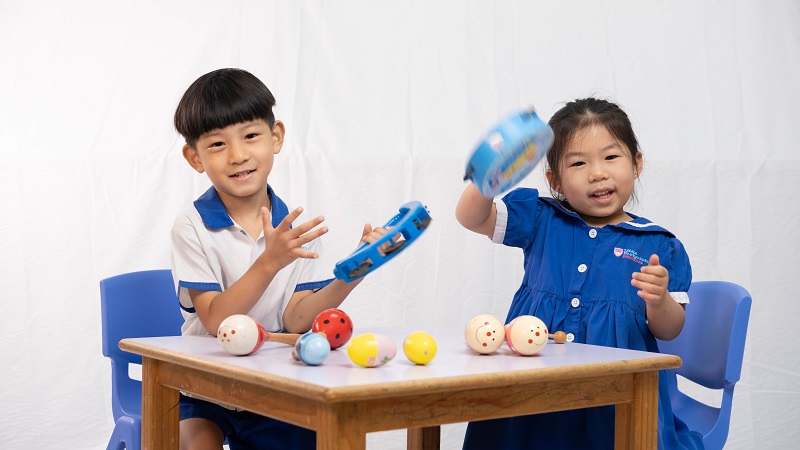
It’s common for most families to be English-speaking these days. Thus, Chinese is hardly spoken at home. This could be because parents are not comfortable or confident in speaking Chinese fluently.
Children may then be reluctant to speak the language due to the lack of exposure since most people around them are speaking English. This may lead to children being disinterested in picking up the Chinese language and limited opportunities for communication.
Growing up in Singapore, we do understand the benefits of being effectively bilingual. In fact, more non-Chinese speaking friends are also mastering the language in recent years. So, how can parents make it interesting when teaching children Chinese?
Fun and simple ways to make learning Chinese fun for preschoolers

#1: Sing catchy Chinese nursery rhymes and songs
Songs are a great way to pick up a language and are often incorporated into the curriculum even for children enrolled in playgroups in Singapore. Think about how K-pop has taken over the world by storm, growing a huge fan base even when majority of their fans don’t speak Korean! Children absorb like sponges when it comes to learning. Start with singing Chinese songs and nursery rhymes during bath time, in the car or simply turn on the music and enjoy a family sing-along together.
#2: Read interactive Chinese books together
Pick fun books that encourage interaction such as textured or lift-a-flap books, so curious fingers can lift flaps and see what’s behind them. Learn new characters like vocabulary as you raise a reader on your lap! Reading aloud with dramatisation makes it extra fun (and funny!) as they listen out for different characters and their voices.

#3: DIY customised flash cards
Children’s flash cards can be bought or you can also make your own to customise the words according to your child’s ability. Write some simple Chinese characters of things around the house on paper and include a picture of it behind, then cut them out. Show these words and pictures to your child to ignite the word-visual association and elicit interest.
#4: Play Chinese games
Using the above flash cards, start a word hunt game that you can play with your preschooler! Some simple words you can try: 桌子,椅子,书包,衣服,鸡蛋,面包,故事书. First, read the words to your child or get your child to read them if he/she knows how to. Next, tell them to search for the items – this usually makes it very exciting as they connect their understanding with a physical item and get active. Whether he/she successfully finds them or encounters difficulties, remember to cheer them on in Chinese too!
#5: Increase the exposure by immersing in Chinese-speaking environments
There’s no denying that exposure is key, and what better than to immerse in real-life situations? Have grandparents or neighbours who speak Chinese? Strike up conversations with them and include your child too. Heading to the wet market? Take your child along and let him/her observe the interaction in a social setting that comprises Chinese and even dialects. Learning opportunities are everywhere and allowing children to see how relevant it is can be a positive motivation for them too.
#6: Learn to write Chinese with different mediums
Skip the endless repeated writing of Chinese characters on exercise books especially if your child lacks the motivation and interest. Like learning English, writing is a developmental milestone when it comes to picking up Chinese. Try these fun writing activities at home with your preschooler and watch him/her learn through play!
#7: Walk the talk
It’s often said that parents are our children’s first teachers and best influencers. To nurture higher receptiveness to learning Chinese, parents can be role models. This helps to set a foundation especially if your child has yet to attend playgroup or childcare in Singapore.
Read Chinese books, learn the lyrics to your favourite Chinese pop songs and sing out loud, watch the news on Channel 8, converse in Chinese with your children - there are many ways we can use our Mother Tongue in our daily lives in natural settings.
If it’s almost impossible to learn Chinese at home, parents can leave this to educators who are able to support their child’s learning. One of the ways is to choose a childcare centre with a robust Chinese programme.

Specialised Chinese programmes at preschools in Singapore
Literacy development starts in infancy and scaffolds further to increase proficiency. Childcare centres like Little Footprints Preschool integrate Chinese programmes into our bilingual curriculum. This means children from 18 months old get to enjoy daily Chinese lessons and are exposed to this second language on a consistent basis.
What are some of the specialised programmes our educators have developed for young learners?
• Tick Tock, It’s Time to Talk
Designed as a home-school partnership activity, children share their thoughts and ideas on a topic or theme in front of their friends and teachers. Besides observing others, children get to hone their oral and public speaking skills while using expressive words and speaking in full sentences. This specialised programme is conducted in both English and Chinese, for children in nursery and kindergarten levels.
• Librarian’s Code
To encourage healthy reading habits, children bring home Chinese storybooks on alternate weeks to read with parents and complete their journal activities. These age-appropriate selected books help relieve parents who are unsure about choosing suitable Chinese books for their preschoolers too.
Wish to nurture a child who enjoys learning Chinese through engaging and effective pedagogy? Find out more about Little Footprints Preschool’s curriculum and how it gives children a good head start in learning.
Book a centre tour to learn more.
Follow us on social media to stay updated on our latest updates and happenings:




